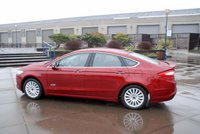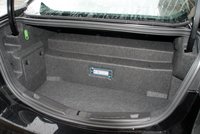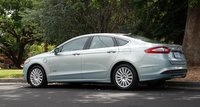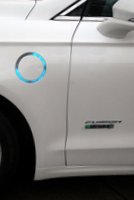Ford’s Everything Car — Super Mileage, Style & Functionality
Clean Fleet Report had two chances to test the 2014 Ford Fusion Energi — the plug-in hybrid version of Ford’s best-selling car — and came away from both with a clear view of why this model is so popular. It hits on all of the key metrics that make a car great, starting with its looks. The Energi version of the Fusion is the supermodel doppelganger who has just done an IPO with a cleantech startup. When the restyled second-generation Fusion first came out in 2013, it was a head-turner. It took a pedestrian midsize car and turned it into something that could easily be mistaken for a more exotic car costing two or three times as much. Two model years later the Fusion still looks fresh.

Beyond looks, the 2014 Ford Fusion represents another strong approach by the company to fuel economy, showcasing its EcoBoost turbocharged smaller engines throughout the lineup, optional start-stop technology as well as offering a hybrid and a plug-in hybrid version. That lets them give a choice of fuel economy ranging from a minimal of 22 mpg city/31 mpg highway/25 mpg combined in the all-wheel-drive based model (which can max out at 25/37/29 with the 1.5-liter EcoBoost in the front-wheel drive version) up to 108 MPGe city (miles per gallon equivalent, which accounts for the miles running on electricity) in the Energi version that Clean Fleet Report tested. In between is the Fusion Hybrid that delivers 44 mpg city/41 mpg hwy/42 mpg combined. Using EPA numbers you should be able to get 550 miles on a tank of fuel, but, of course, if you plug in more and take short trips, that range can extend exponentially.
Finally, the 2014 Ford Fusion Energi and its siblings represent the epitome of the monstrous midsize car market. Along with the style and fuel economy the car will comfortably seat five adults. It has all the bells and whistles available and many of them are standard features, including leather heated front seats, Sirius/XM radio and SYNC with MyFord Touch. The only engine available is the 2-liter Atkinson cycle four-cylinder engine mated to a 118 horsepower electric motor and an electronically controlled continuously variable transmission (eCVT). The power system’s final component is its 7.6 kWh lithium-ion (Li-Ion) battery (with 35 kW of peak power), which will supply power to drive up to 21 miles under electric power alone.
Driving Experience: On the Road
The 2014 Fusion Energi drives like it looks — smooth and stylish. The front independent MacPherson strut and rear independent multilink suspensions, both of which have stabilizer bars, deliver a stable on-highway ride and solid cornering, aided by the added weight of the batteries in the bottom of the trunk. Braking is as you’d expect from a best-selling contemporary sedan, straight and true from the four-wheel discs with ABS and integrated regenerative braking, which convert the kinetic energy of braking into electricity and store it in the Li-Ion battery. A “Brake Coach” feature in the instrument cluster teaches you how to maximize your regen effectiveness by giving you instant feedback on how much energy you were able to store.

Driving Experience: Interior
The range of electronic gadgetry available on the 2014 Ford Fusion Energi is extensive. Standard features include a rear-view camera and optional are active park assist (which will park your car for you), a reverse-sensing system, adaptive cruise control, blind spot/cross-traffic alert and a lane-keeping system.

Inside all of the usual power equipment is standard, including a 10-way driver’s seat with power lumbar support and a six-way passenger seat. The standard audio system includes an AM/FM stereo with CD player, MP3 capability and six speakers. The optional Sony-branded audio system doubles the number of speakers and adds HD Radio technology.

Ten airbags round out the interior, which also includes a trunk pass-through and 60/40 split fold-down rear seats. Luggage space is compromised with the battery taking up a good portion of the trunk. We found when traveling with three adults that we ended up having to use the back seat in order to carry all of the luggage.
Driving Experience: Exterior
The Fusion has been accused of borrowing its exterior style extensively from a former Ford stablemate, Aston Martin. We don’t see anything wrong with that since we find it a truly exquisite design. The aerodynamics are there and we feel it’s got more street presence than its two main plug-in competitors — the Toyota Prius Plug-in and the Honda Accord Plug-in Hybrid.
Standard wheels are 17-inch painted aluminum with 18-inch ones optional. The whole package looks fairly svelte for weighing in at just under 4,000 pounds.
Charging is through a port in the front fender. A lighted ring around the charge port glows to indicate the state of charge, a handy an aesthetically pleasing touch.
Pricing & Warranties
Though we tested a 2014 model, here are the latest prices on the just-release and virtually identical 2015 models of the Fusion. The prices do not include the $825 delivery charge.
Fusion S $21,970
Fusion SE $23,935
Fusion Titanium $30,600
Fusion Hybrid S $26,270
Fusion Hybrid SE $27,280
Fusion Hybrid Titanium $32,600

Fusion Energi SE $34,700
Fusion Energi Titanium $36,500
The Energi models come with a higher level of standard equipment to accompany their higher initial price tags so true apple-to-apple price comparisons need to be made with the SE and Titanium models, and even then it’s not strictly comparable. The indicated “step” between the basic Fusion and the Hybrid is about $2,500-$3,500 and the “step” between the Hybrid and Energi models is roughly $4,000 to $5,000. Ford has been lowering prices on its hybrid models during the current generation and claims the payback through reduced fuel costs is roughly three-and-a-half years.
The Energi has a few extra warranties to cover its unique electronic components. Those warranties vary between California and some of the other 49 states that follow California’s emissions regulations.
Bumper-to-bumper 3-years/36,000-miles
Powertrain 5-years/60,000-miles
Safety Equipment 5-years/60,000-miles
Corrosion 5-years/Unlimited miles
Electronic Components 8-years/100,000-miles
California Warranty 15-years/150,000-miles
2014 Ford Fusion Energi Overview
Ford has come a long way since introducing its first hybrid, the Escape SUV, 10 years ago. The hybrid systems have become more sophisticated, more powerful and more integrated into the overall vehicle. Ford now assembles its own batteries from cells purchased from Sanyo, which has helped both in cost reduction and vehicle integration.

The choice for a car buyers looking for a plug-in hybrid boils down to three basic contenders with some options around the edges. In addition to the Fusion Energi, Toyota has a plug-in version of its Prius hybrid and Honda offers a plug-in version of its best-selling Accord. Slightly smaller is the Chevy Volt and slightly larger is the Ford C-Max Energi, which shares the Fusion propulsion system but is built more like a wagon. Rounding out the plug-in hybrid universe are three high-end luxury cars — the Cadillac ELR, Porsche Panamera SE-Hybrid and BMW i8. The group will be growing in the coming years (next to join will probably be the Mitsubishi Outlander plug-in hybrid), but it has the distinction of presenting electrically-enhanced models of three of the best-selling cars on the market.
Compared to its head-to-head competition from Toyota and Honda the 2014 Ford Fusion Energi has more power, more electric-only range and comparable EPA mileage ratings. We think it’s got styling that puts it beyond those two and pricing that’s comparable when you look at equipment. The Fusion has the biggest gas tank and thus the longest range, offers the most variety of colors and equipment. The Accord is slightly longer overall, but the interior volume is almost the same; it’s is priced higher than the Fusion. The Prius is smaller and also the least expensive of the three and has the most cargo room because of its hatchback configuration.
It’s hard to go wrong with any of these, but we lean toward the Fusion because of its capability of being an all-electric driver (for 20-mile trips) combined with the versatility to take on longer stretches. We like its styling, handling and high-tech features. We like that it seems to get better every year. When given the option of beauty and brains, we’ll take that option every time.
Related Stories You Might Enjoy:
Comparison Road Test: Toyota Prius & Prius Plug-in
Honda Accord Plug-in Hybrid Review
Best Electric Cars and Plug-in Hybrids for 2014

I lease a Fusion Energi. I don’t think “blind spot/cross-traffic alert and a lane-keeping system” is standard. Also previously leased a Chevy Volt so I can make some direct comparisons. The Volt is definitely and feels smaller inside; but more importantly has terrible visibility issues for traffic lights and crossing traffic/pedestrians due to an enormous A pillar and windshield angle. On the other hand it looks like Ford engineers spent about 1 afternoon integrating the lithium battery (which I’m pretty sure is Samsung cells, not Sanyo, which I think are only used in the Hybrid not Plug-in). Ford literally opened the trunk, dumped the pack in, and poured carpet over it leaving you room for about 5 grocery packs and definitely no suitcases larger than a carryon or anything long (except for a tiny passthrough). Chevy cleverly integrated a two times larger battery under the rear seats and up the central column. The Ford feels more luxurious inside but drives less sporty than the Volt. I can nearly floor the Volt and the EV drive will take me almost up to 60 mph. The Ford gas engine on the other hand cuts in almost immediately and then does not cut out for a while once it is in. Overall I have liked both cars but Chevy needs to improve visibility issues immediately as well as lower the price more, and Ford needs to improve their battery location and tune the power sharing control algorithm between engine and emptor.
@Ed,
Thanks for your well thought-out comments and your ability to offer personal experience. You’re right, as I mention in the article the blind spot/cross-traffic alert and lane-keeping system” is an option. You validate everything I said about the Volt and the Fusion Energi comparison. I think the handling advantage you’re ascribing to the Volt is just the extra battery weight properly placed very low to the ground. Not a bad thing, but the Energi’s on-road performance comes more from its suspension than low-slung weight. I agree wholeheartedly about the battery placement in the Energi; it’s its biggest short-coming in my view and countermands its great driving range. On the other hand, having a full three-passenger back seat solves quite a few storage and passenger-hauling issues as well. I think the Volt visibility issues may be more easily addressed than the Energi battery packaging ones, but both are not trivial. The next generation Volt (due next year as a 2016 model) should be a gauge of whether they’re listening to customers like you. In the meantime, we road-tested the Volt here: https://cleanfleetreport.com//road-test-2014-chevrolet-volt/. –Ed.